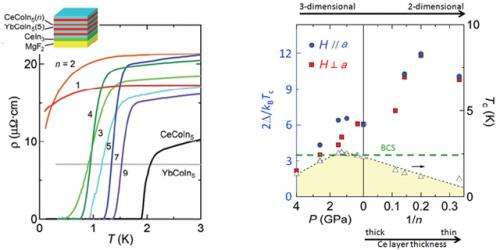Extremely strong coupling superconductivity of heavy-electrons in two-dimensions

The ultimately strong electron-electron interaction in metal is realized in the so-called heavy-fermion compound containing rare earth elements, in which the electron effective mass is enhanced by a few hundred times the free electron mass.
The group of Yuta Mizukami, Yuji Matsuda and Takasada Shibauchi in Department of Physics and Takahito Terashima in Research Center for Low Temperature and Materials Sciences, has succeeded in achieving the first experimental realization of ‘heavy superconducting electrons’ in a two-dimensional lattice, which were obtained by fabricating heterostructures unavailable in nature.
Superlattices with heavy-fermion CeCoIn5 and nonmagnetic YbCoIn5 layers are grown alternately by the molecular-beam-epitaxy technique (Fig. 1). Superconductivity is observed even in superlattice with one-unit-cell thick CeCoIn5 layers, demonstrating a heavy-electron superconductivity with purely two-dimensional electron correlations.

Most remarkably, the superconductivity in superlattices persists under significantly higher reduced magnetic fields than in the bulk, implying that the force ("glue") holding together the superconducting electron pairs takes on an extremely strong coupled nature as a result of two-dimensionalization (Fig. 2) -- a situation reminiscent of the high-Tc cuprates.
More information: The article, " Extremely strong coupling superconductivity in artificial two-dimensional Kondo lattices " by Y. Mizukami, H. Shishido, T. Shibauchi, M. Shimozawa, S. Yasumoto, D. Watanabe, M.Yamashita, H. Ikeda, T. Terashima, H. Kontani, Y. Matsuda was published in Nature Physics. Published online 09 October 2011. DOI:10.1038/nphys2112
Provided by Kyoto University





















